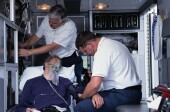
MONDAY, Aug. 13 (HealthDay News) — A test based on certain cardiac enzymes could help emergency department staff spot heart attacks in incoming patients within an hour, a new study finds.
The test, called high-sensitivity cardiac troponin (hs-cTn), would be used along with electrocardiography and physical exams to improve the early diagnosis of heart attacks for patients coming to the ER complaining of chest pain, the Swiss researchers said.
As one expert not connected to the study explained, cardiac enzymes called troponins can point to heart attack.
“Cardiac troponins are highly specific for the presence of myocardial cell necrosis (death of heart muscle),” said Dr. Hal Chadow, co-director of the Division of Cardiology at Brookdale University Hospital and Medical Center in New York City. Although troponins are most often elevated in people who have suffered a heart attack, he said, they also can be linked to other conditions such a heart failure, pulmonary embolisms (clots in the lungs) and stroke.
Chadow said accurate, rapid means of confirming heart attacks in the ER are needed.
“Approximately 5.5 million patients are seen in [U.S.] emergency departments annually for chest pain,” he said, and “rapid diagnosis and early risk stratification are important goals.”
Cardiac troponin measurement may be a key ingredient to this process, he added, since “previous studies have demonstrated very low 30-day event rates in patients with no elevation in cardiac troponin.”
The new study was led by Dr. Tobias Reichlin of University Hospital Basel in Switzerland and published Aug. 13 in the journal Archives of Internal Medicine. Reichlin’s team tracked nearly 900 patients with severe chest pain who visited the emergency room, including almost 150 for whom heart attack was confirmed as the final diagnosis.
About half of all patients were assessed using the new method.
The new formula gauged the patients’ troponin value upon arrival and then tracked changes in troponin over the next hour.
Using the method, the researchers ruled out heart attack in 60 percent of the patients, found evidence of heart attack in 17 percent and put the other 23 percent into a group to be “observed” over the next hour.
The 30-day survival rate was 99.8 percent among the patients who did not have a heart attack, 98.6 percent among those who were placed under observation and 95.3 percent in the patients who had a heart attack.
“The use of this [formula] seems to be safe, significantly shortens the time needed for rule-out and rule-in of [heart attack], and may obviate the need for prolonged monitoring and serial blood sampling in three of four patients with chest pain,” the authors concluded.
Still, experts cautioned that more study may be needed before this approach becomes routine.
Since troponin-based tests can point to a wide range of cardiac conditions, using them for spotting heart attack alone may not be advised, said Dr. Robert Glatter, an emergency physician at Lenox Hill Hospital in New York City.
“It is important to realize that high-sensitivity troponins are not just a test to ‘rule in’ or ‘rule out’ [heart attack],” he said. “Instead, they are a valuable tool to risk-stratify patients with chest pain who may have a number of potentially lethal [conditions].”
Glatter noted that troponin tests might miss other potentially lethal heart conditions “where there may be no troponin elevation.”
“If these high-sensitivity troponin assays are widely embraced, it will likely prolong the emergency department length of stay and may potentially worsen the crowding in our nation’s emergency departments,” Glatter said. “They cannot be seen as the answer to our dilemma of triaging high-risk chest-pain patients when they ultimately lead to more doubt and questions down the line.”
For his part, Chadow said that although the troponin-based test may be “an important addition to our armamentarium in evaluating chest-pain patients in the ER, I agree that more studies are needed in a larger number of patients to confirm these findings.”
The study was funded by research grants from the Swiss National Science Foundation; the Swiss Heart Foundation; medical technology companies Abbott, Roche and Siemens; and the Department of Internal Medicine at University Hospital Basel.
More information
The U.S. National Heart, Lung, and Blood Institute provides more information on heart attacks.

